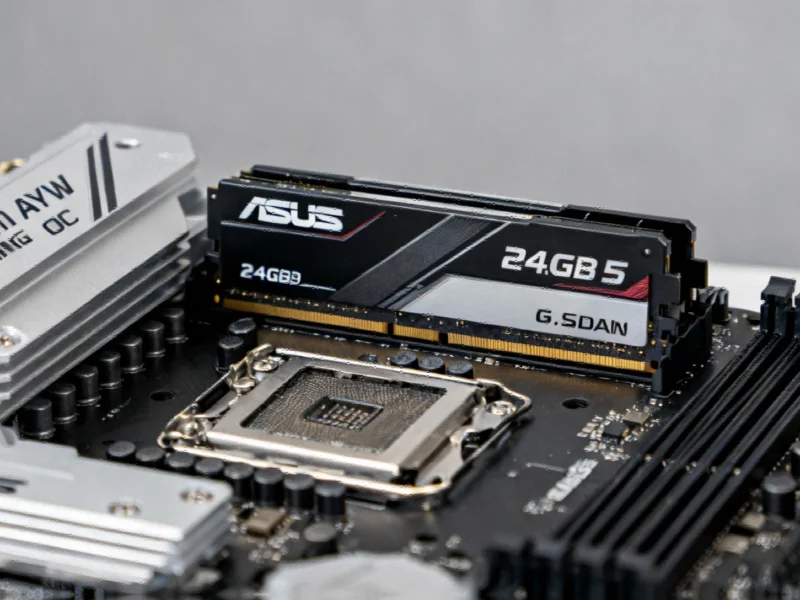Budget Gaming Motherboard Achieves Elite Memory Performance
The ASUS B850M AYW Gaming OC continues to demonstrate remarkable capabilities in the memory overclocking arena, recently pushing a 2x 24 GB G.Skill DDR5 kit to an impressive 10,600 MT/s. This achievement challenges conventional wisdom about what’s possible with mid-range motherboards and represents a significant milestone for AMD platform memory performance.
While AMD’s Zen 4 and Zen 5 architectures have shown strong memory support capabilities, reaching speeds beyond 10,000 MT/s requires a carefully curated combination of components. The motherboard’s 1 DPC (DIMM per channel) memory configuration proves instrumental in achieving these extreme frequencies while maintaining stability and reasonable latencies.
Technical Breakdown of the Achievement
The recent testing utilized G.Skill’s 48 GB (2x 24 GB) DDR5 memory kit running at CL34 timings with a 1:2 memory ratio. What makes this result particularly noteworthy is the comparison to previous benchmarks where the same motherboard achieved 10,400 MT/s using a Ryzen 5 8500G processor at CL50. The improvement to 10,600 MT/s with tighter CL34 timings demonstrates significant optimization in both motherboard firmware and memory controller capabilities.
ASUS officially lists maximum supported DDR5 speeds of 9600 MT/s with Ryzen 8000 series processors and 8400 MT/s with Ryzen 9000 chips. This makes the 10,600 MT/s achievement even more remarkable, as it substantially exceeds manufacturer specifications. The results highlight how proper component matching and tuning can unlock hidden performance potential that isn’t immediately apparent from published specifications.
Competitive Landscape and Value Proposition
The B850M AYW Gaming OC’s performance places it in direct competition with more expensive alternatives, including MSI’s B850MPOWER, which retails for over $250. At under $200, the ASUS motherboard represents exceptional value for enthusiasts seeking high memory performance without the premium price tag typically associated with such capabilities.
This achievement follows ASUS’s continued expansion into performance computing segments, demonstrating the company’s commitment to pushing technological boundaries across their product lineup. The motherboard’s success in memory overclocking mirrors trends seen in other computing sectors, where advanced technologies are creating new performance paradigms across the industry.
Industry Implications and Future Possibilities
The ability to achieve such high memory speeds on a budget-oriented motherboard has significant implications for the broader computing market. It suggests that extreme memory performance is becoming more accessible to mainstream users rather than remaining the exclusive domain of high-end enthusiasts. This democratization of performance aligns with broader industry trends toward making advanced computing capabilities more widely available.
As computing technology continues to evolve, we’re seeing similar advancements in related fields. The technical sophistication behind AI agents and the increasing regulation of algorithmic systems demonstrate how performance improvements must be balanced with responsible implementation. Meanwhile, display technology continues to advance, as evidenced by new streaming bundles and content delivery innovations that complement hardware advancements.
Practical Considerations for Enthusiasts
For users looking to replicate these results, several factors deserve consideration. The specific memory kit used, processor memory controller quality, and motherboard BIOS version all play critical roles in achieving stable high-frequency operation. It’s worth noting that while the B850M AYW Gaming OC demonstrates exceptional memory overclocking capabilities, actual results may vary depending on individual component samples and cooling solutions.
The achievement also raises questions about future display technology integration, particularly as premium computing devices increasingly adopt advanced display technologies that can benefit from higher memory bandwidth. As systems become more integrated, the relationship between memory performance and overall user experience continues to strengthen.
This memory overclocking milestone represents more than just a technical achievement – it demonstrates how careful engineering and optimization can extract maximum performance from affordable hardware. For budget-conscious enthusiasts and professionals alike, such developments make high-performance computing more accessible than ever before.
Based on reporting by {‘uri’: ‘wccftech.com’, ‘dataType’: ‘news’, ‘title’: ‘Wccftech’, ‘description’: ‘We bring you the latest from hardware, mobile technology and gaming industries in news, reviews, guides and more.’, ‘location’: {‘type’: ‘country’, ‘geoNamesId’: ‘6252001’, ‘label’: {‘eng’: ‘United States’}, ‘population’: 310232863, ‘lat’: 39.76, ‘long’: -98.5, ‘area’: 9629091, ‘continent’: ‘Noth America’}, ‘locationValidated’: False, ‘ranking’: {‘importanceRank’: 211894, ‘alexaGlobalRank’: 5765, ‘alexaCountryRank’: 3681}}. This article aggregates information from publicly available sources. All trademarks and copyrights belong to their respective owners.



